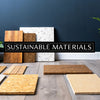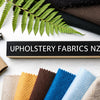Top 7 Best Fabrics for Curtains in 2025 | Your Guide

Unveiling the Perfect Drape
Choosing the best fabric for curtains significantly impacts a room's light, insulation, and atmosphere. This guide presents seven top choices for curtains, outlining their properties, ideal applications, and care requirements. Discover the perfect drape, whether it's breezy linen or luxurious velvet, to enhance your New Zealand or Australian home. From cotton to blackout fabric, find the best fabric for curtains to achieve your design vision.
1. Cotton
When searching for the best fabric for curtains, cotton often tops the list. This natural fiber, derived from cotton plants, offers a blend of versatility, breathability, and ease of care that makes it a favourite for window treatments. Its widespread availability in various weights, weaves, and finishes allows it to adapt to diverse interior design styles, from relaxed and casual to elegantly formal, making it suitable for a wide range of applications across New Zealand and Australia.
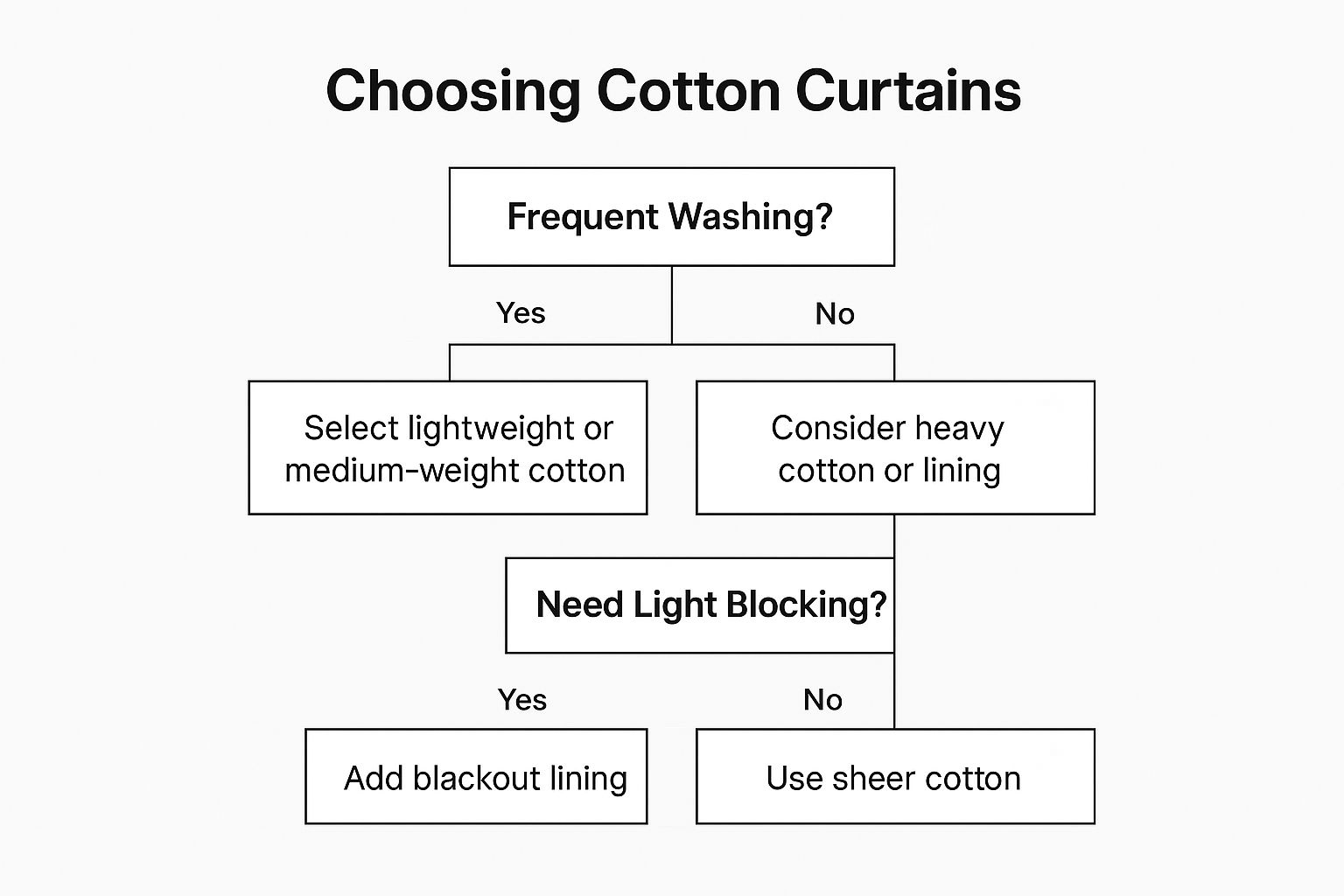
The infographic below provides a decision tree to guide you through choosing the right cotton curtain for your needs.
Cotton's inherent breathability promotes good airflow, contributing to a comfortable indoor environment. This natural fiber is also hypoallergenic, making it a great choice for sensitive individuals. Its affordability and ease of maintenance, being machine washable, further enhance its appeal. From sheer muslin to durable canvas and sturdy duck cloth, the variety of cotton weaves allows for diverse applications, from light and airy curtains to more structured and dramatic drapes. Its ability to hold dye well results in vibrant colours and prints, offering endless design possibilities. Brands like Pottery Barn, IKEA (with their globally popular RITVA curtains), and Crate & Barrel showcase the diverse applications of cotton in their curtain collections. Even renowned tastemakers like Martha Stewart, West Elm (with their organic cotton lines), and Anthropologie (known for their distinctive printed designs) have championed cotton in their home collections.
The decision tree visualizes the process of selecting the ideal cotton curtain based on desired light control and insulation needs.
For those seeking eco-friendly options, cotton's biodegradability makes it a sustainable choice. However, it's crucial to be aware of cotton's susceptibility to wrinkling and shrinkage. Exposure to direct sunlight over time can also cause fading. Lightweight cotton doesn't offer significant insulation, and its light-blocking capabilities are limited unless lined or used in heavier weights.
Pros:
- Highly breathable and allows for good airflow
- Machine washable and easy to maintain
- Biodegradable and environmentally friendly
- Hypoallergenic and suitable for sensitive individuals
- Affordable and widely available
Cons:
- Prone to wrinkling and shrinkage
- May fade when exposed to direct sunlight over time
- Lightweight cotton doesn't provide much insulation
- Not as effective for blocking light unless lined or in heavier weights
Tips for Using Cotton Curtains:
- Pre-wash: Always pre-wash cotton curtains to account for potential shrinkage before hanging.
- Weight Selection: Opt for heavier weights like cotton duck for better draping and a more luxurious feel.
- Lining: If light-blocking is a priority, consider lining your cotton curtains with blackout material. This addition will also enhance insulation and privacy.
- Header Tape: Add header tape to create a more structured and polished look, allowing for different hanging styles.
- Ironing: Iron on medium heat as needed to remove wrinkles and maintain a crisp appearance.
When to Use Cotton Curtains:
Cotton curtains are a versatile choice suitable for various spaces in both residential and commercial settings throughout NZ and Australia:
- Bedrooms: Choose heavier cotton weaves or lined curtains for better light control and privacy.
- Living Rooms: Cotton curtains in lighter weights and various prints can add a touch of elegance and style.
- Kitchens and Dining Areas: Cotton's breathability makes it a practical choice for these spaces.
- Commercial Spaces: Cotton curtains offer an affordable and aesthetically pleasing option for offices, cafes, and retail stores.
- Eco-Conscious Homes: Opt for organic cotton options for a sustainable and environmentally friendly choice.
The decision tree simplifies the selection process by guiding users through key considerations such as light filtration requirements and the need for thermal insulation. By following the branches of the tree based on their preferences, users can confidently determine the most suitable cotton curtain weight and construction for their specific needs.
2. Linen
Linen is a premium natural fabric woven from flax plant fibers, making it a popular choice for curtains, especially for those seeking a sophisticated yet relaxed aesthetic. Its unique texture and excellent draping qualities create an elegant, timeless look that complements various interior design styles. Linen curtains offer a beautiful balance of filtered light and privacy, adding a touch of understated luxury to any room. They are particularly well-suited to the bright, airy interiors popular in New Zealand and Australia.
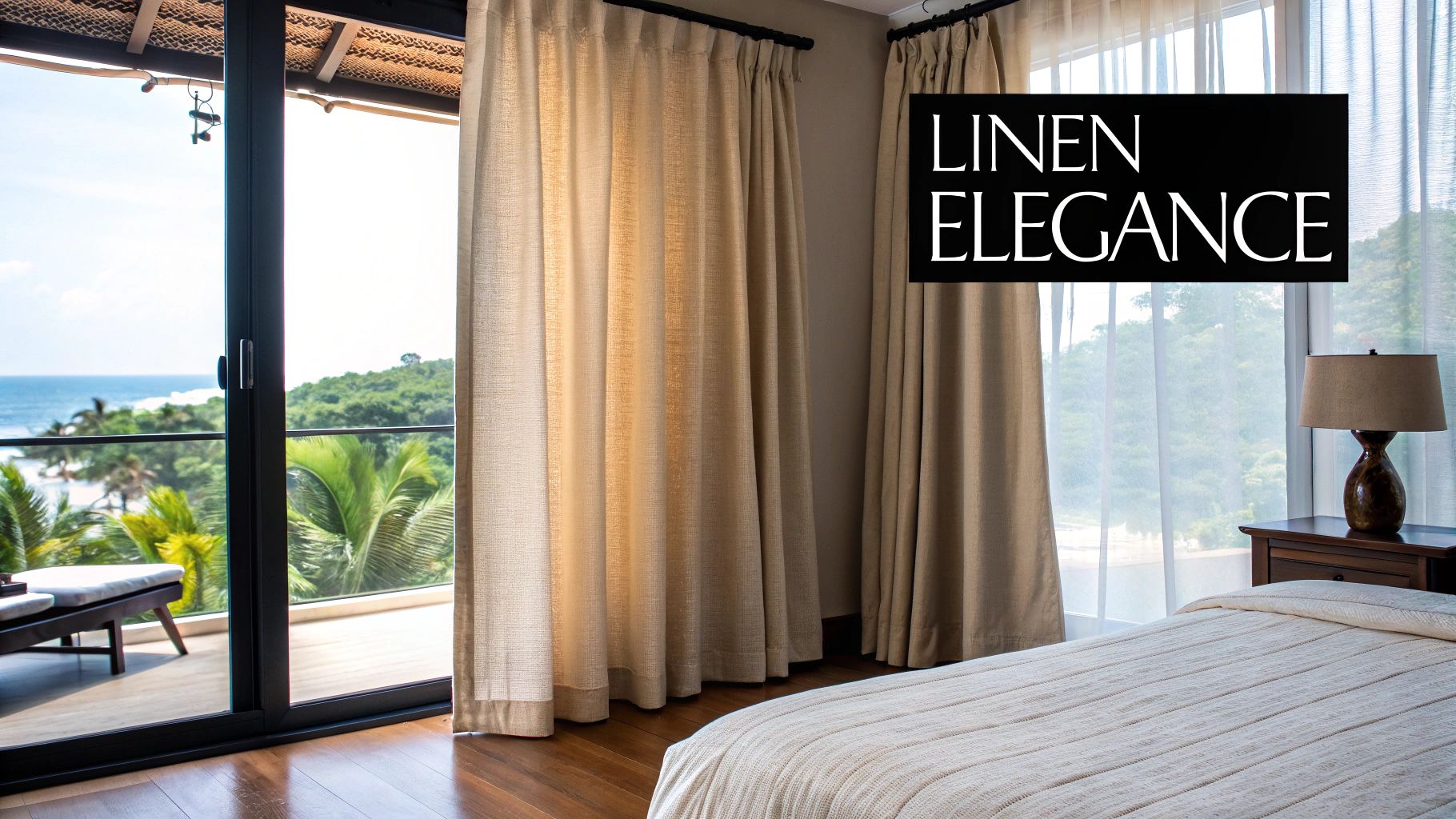
This natural fiber boasts a distinctive slubbed texture which contributes to its characteristic relaxed appearance. Linen is also highly breathable and moisture-wicking, making it ideal for humid climates. As a bonus, it becomes softer with each wash, promising increased comfort and luxury over time, while maintaining its inherent strength. From sheer to heavy weights, linen offers versatility in light control and privacy. It's available in a range of colours, although neutral tones best showcase the fabric's natural beauty and texture.
Why Linen Deserves its Place on the "Best Fabric for Curtains" List:
Linen’s durability, elegance, and eco-friendly nature secure its spot as a top contender for the best curtain fabric. Its inherent strength ensures longevity, while its natural luster improves with age, making it a truly worthwhile investment. The fabric's breathability makes it an excellent choice for temperature regulation, contributing to a comfortable indoor environment year-round. For environmentally conscious consumers, linen’s sustainable production process, from flax cultivation to weaving, adds to its appeal. Learn more about Linen
Pros:
- Extremely durable and long-lasting
- Excellent temperature regulation properties
- Naturally resistant to moths and bacteria
- Filters light beautifully while maintaining privacy
- Environmentally sustainable production process
Cons:
- More expensive than many other curtain fabrics
- Wrinkles easily (though this can be part of its charm)
- May require professional cleaning for best results
- Can be damaged by bleach and strong detergents
- Prone to shrinkage if not properly pre-washed
Examples of Successful Implementations:
Inspiration for incorporating linen curtains can be found in collections from renowned brands such as Restoration Hardware's Belgian Linen Curtain Collection, Parachute Home's Linen Curtain Panels, and Eileen Fisher's Washed Linen Curtains for Garnet Hill. The influence of Belgian and French interior designers, alongside tastemakers like Kelly Wearstler and Nate Berkus, as well as the popularity of Scandinavian design, have cemented linen's place in modern interiors. Luxury home brands in New Zealand like McKenzie & Willis and Tessuti also offer a curated selection of linen curtains and fabrics.
Tips for Using Linen Curtains:
- Embrace the wrinkles: Linen's natural wrinkles contribute to its casual elegance. However, if you prefer a crisper look, steaming is recommended.
- Account for shrinkage: Allow extra length when measuring for your curtains, as linen may shrink slightly after washing.
- Layering: Combine linen curtains with sheer panels to create a sophisticated, multi-dimensional window treatment.
- Lining options: Unlined linen provides a casual, light-filtering effect, while lined linen offers more structure and light blockage.
- Colour choices: Opt for neutral colours to highlight linen's natural beauty and texture.
Linen curtains offer a timeless, elegant solution for window treatments. While the initial investment might be higher than other fabrics, their durability, unique aesthetic, and eco-friendly nature make them a worthwhile choice for discerning homeowners and designers seeking quality and sustainability.
3. Velvet
Velvet earns its spot on the list of best fabrics for curtains thanks to its luxurious appeal and impressive functionality. This tufted fabric, characterized by a dense pile and soft, smooth surface, adds a touch of opulence to any space. While traditionally made from silk, modern velvet curtains are now available in a variety of fibres, including cotton, polyester, and blends, making them a versatile choice for diverse budgets and needs. Velvet’s inherent light-absorbing qualities create rich colour depth and provide excellent insulation, both for temperature and sound. This makes velvet a particularly good choice for NZ homes looking to maximise warmth during colder months.
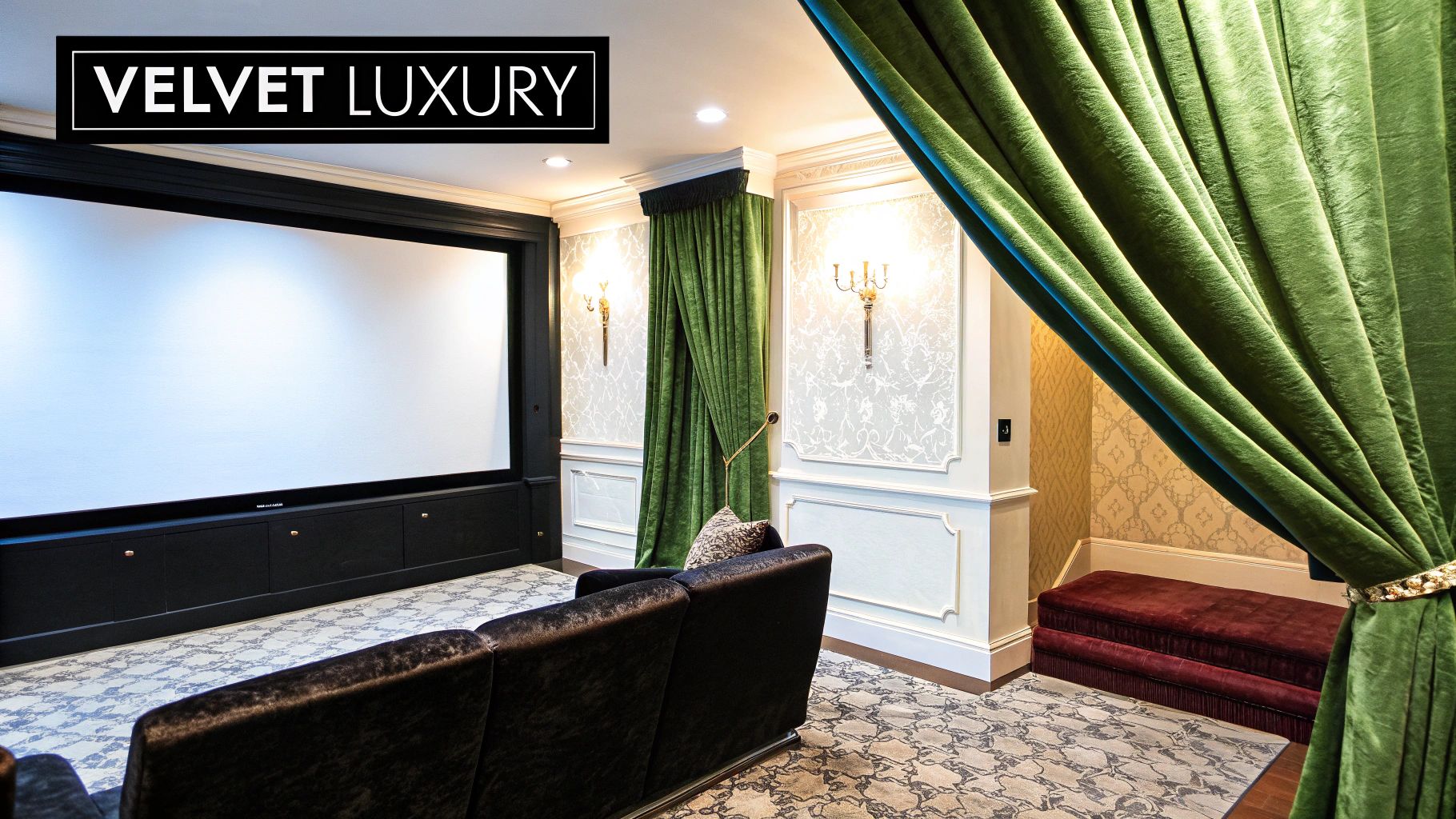
The plush, dense pile of velvet gives it a distinctive soft hand-feel and contributes to its excellent draping capabilities. Its substantial body creates elegant folds and adds a sense of grandeur to windows. From plush cotton velvets to lustrous silk blends, the variety of weights and compositions allows you to achieve different levels of formality and light control. For instance, heavier velvets provide superior room darkening and thermal insulation, ideal for bedrooms or media rooms. Lighter weight velvets, perhaps in a linen or cotton blend, could be used in living areas, offering a softer touch and diffused light. Learn more about Velvet.
Features:
- Plush, dense pile with a distinctive soft hand-feel
- Rich colour depth due to its light-absorbing surface
- Available in different weights and compositions
- Excellent draping with substantial body
- Superior sound and temperature insulation
Pros:
- Provides excellent room darkening capabilities
- Offers superior thermal insulation, perfect for New Zealand's variable climate
- Absorbs sound, improving room acoustics
- Creates a luxurious, high-end appearance
- Highly durable when properly maintained
Cons:
- Attracts dust and requires regular maintenance
- Can be expensive, especially silk velvet
- Prone to crushing and marking
- Typically requires professional cleaning
- May fade if exposed to direct sunlight
Examples:
- West Elm's Lush Velvet Curtain Collection
- Anthropologie's Velvet Louise Curtains
- The historic velvet draperies of The Palazzo Doria Pamphilj in Rome serve as a testament to velvet's enduring elegance.
Tips for Using Velvet Curtains:
- Use steaming rather than ironing to remove wrinkles.
- Install with proper hardware that can support the fabric’s weight.
- Choose synthetic velvet blends for rooms with high sunlight exposure to minimise fading.
- Vacuum regularly with a brush attachment to maintain the fabric's appearance.
- Opt for lined velvet curtains for maximum insulation and light blocking.
Velvet in Design:
Popularised by classical European palace interiors, velvet remains a favourite amongst renowned interior designers like Kelly Wearstler and Jonathan Adler. The fabric also enjoys a strong presence in luxury home decor lines from fashion houses such as Versace Home and Ralph Lauren Home, demonstrating its lasting appeal. For those considering velvet, remember that proper care is essential for preserving its luxurious quality. While the initial investment may be higher than other fabrics, the enduring elegance and performance benefits make velvet a worthwhile consideration for discerning homeowners and designers in New Zealand and Australia.
4. Silk
Silk, a luxurious natural protein fiber produced by silkworms, earns its place on the list of best fabrics for curtains due to its unmatched luster, elegant drape, and ability to create a sophisticated ambiance. If you're looking to add a touch of opulence to your New Zealand home or commercial space, silk curtains are a premium choice worth considering. Its natural sheen beautifully catches and plays with light, transforming any room into a haven of elegance. This makes it a particularly appealing option for discerning homeowners, interior designers, and architects, as well as hospitality businesses aiming for a high-end aesthetic.
Silk curtains are available in a range of weights, from gossamer sheers that diffuse light to heavy charmeuse that offers more privacy. This versatility allows it to be used in various settings, from bedrooms and living rooms to formal dining areas and even commercial spaces like high-end restaurants and hotel lobbies. The shimmering appearance of silk changes with the light, adding depth and visual interest that synthetic fabrics often lack. Its exceptionally smooth texture further enhances the luxurious feel.
Pros:
- Unmatched natural luster and depth of color: Silk possesses a unique sheen and depth of color that synthetic fabrics struggle to replicate.
- Excellent draping qualities: Silk falls into elegant, flowing folds, creating a sophisticated and polished look for your window treatments.
- Natural flame resistance: Silk is naturally flame-resistant, adding a layer of safety to your interiors.
- Moderate insulation properties: While not as insulating as heavier fabrics like wool, silk does provide some temperature regulation, which can be beneficial in New Zealand's varied climate.
- Hypoallergenic qualities: Silk is a naturally hypoallergenic material, making it a good option for those with sensitivities.
Cons:
- Very expensive: Silk is a premium fabric and significantly more expensive than most other curtain materials.
- Extremely vulnerable to sun damage and fading: Direct sunlight can quickly damage and fade silk curtains, making careful placement and lining essential. This is particularly important in sunny New Zealand.
- Water spots easily and may require professional cleaning: Silk is delicate and prone to water spotting. Cleaning often requires professional dry cleaning, adding to the overall cost.
- Deteriorates over time when exposed to environmental factors: Silk can degrade over time due to exposure to light, humidity, and other environmental factors.
- Poor resistance to abrasion and wear: Silk is not as durable as other fabrics and can be prone to snags and tears, especially in high-traffic areas.
Examples of Successful Implementation:
- The opulent silk curtains in Buckingham Palace's state rooms exemplify the fabric's regal appeal.
- Jim Thompson's Thai silk curtains grace luxury hotels worldwide, showcasing the fabric's rich texture and vibrant colours.
- Designer brands like Fortuny and Rubelli create iconic silk curtain fabrics that are highly sought after by interior designers and architects.
Tips for Using Silk Curtains:
- Always line silk curtains: Lining is crucial to protect silk from sun damage and fading, especially in New Zealand's strong sunlight.
- Consider interlining: Interlining adds body and fullness to silk curtains, improving their drape and insulation properties.
- Dry cleaning only: Never machine wash silk curtains. Always opt for professional dry cleaning.
- Install away from direct contact with windows: Avoid direct contact with windows to prevent moisture damage and water spotting.
- Consider silk blends: For high-traffic areas, consider silk blends for improved durability. This can be a good compromise for busy households or commercial spaces.
Popularized By:
Silk curtains have a long history of use in traditional Asian interiors, particularly in Chinese and Japanese design, as well as in European aristocratic homes and palaces. Today, the use of silk continues to be championed by luxury interior designers and high-end fabric houses, solidifying its status as a premium window treatment choice.
While silk requires careful maintenance and comes with a higher price tag, its undeniable beauty and luxurious feel make it a worthwhile investment for those seeking to create truly elegant and sophisticated interiors. By following the tips above, you can ensure your silk curtains remain a stunning focal point in your New Zealand home or commercial space for years to come.
5. Polyester
Polyester is a powerhouse in the world of curtains, and its widespread popularity is well-deserved. As a synthetic fabric crafted from petroleum-based fibers, it offers a compelling combination of affordability, durability, and ease of care, making it a top contender when considering the best fabric for curtains, especially for budget-conscious projects or high-traffic areas. Modern manufacturing techniques mean polyester curtains are no longer limited to basic styles. They now come in a vast array of textures, weights, and finishes, often mimicking the look of more expensive natural fabrics like linen or silk, while offering superior practical benefits.
Polyester's strength lies in its inherent resilience. It's naturally wrinkle and shrink-resistant, meaning your curtains will maintain their shape and appearance over time without the need for constant ironing or adjustments. Its excellent color retention also ensures your chosen hue remains vibrant, even with prolonged exposure to sunlight. Furthermore, polyester can be engineered for specific properties, such as flame retardancy – a crucial consideration for commercial spaces and hospitality businesses – or blackout capabilities for light-sensitive environments. This makes polyester an excellent choice for New Zealand and Australian homeowners looking for durable and versatile window treatments.
Pros:
- Very affordable: Compared to natural fibers like linen or silk, polyester offers significant cost savings.
- Extremely durable and long-lasting: Polyester curtains can withstand regular use and washing without showing signs of wear and tear.
- Easy to clean: Most polyester curtains are machine washable, simplifying maintenance and saving you time and effort.
- Resistant to mildew and moths: Unlike natural fibers, polyester is inherently resistant to these common household pests.
- Holds its shape well: Polyester drapes beautifully and resists sagging, maintaining a polished look.
Cons:
- Less breathable than natural fibers: This can make polyester less suitable for humid climates or rooms requiring high ventilation. However, blending polyester with natural fibers can mitigate this issue. Learn more about Polyester and other fabric options.
- Can have a less premium look and feel: While modern polyester can closely mimic natural fabrics, some may still perceive a difference in texture and overall quality.
- Static electricity can attract dust: This can be a minor inconvenience, requiring more frequent dusting.
- Not biodegradable or environmentally friendly: As a petroleum-based product, polyester isn't a sustainable choice.
- May release microplastics when washed: This contributes to environmental pollution and is a growing concern for eco-conscious consumers.
Examples:
- IKEA's SANELA polyester velvet curtains offer a luxurious look at an affordable price.
- Target's Room Darkening Curtain Panels provide excellent light control and privacy.
- Amazon Basics Blackout Curtain Sets are a budget-friendly option for complete light blockage.
Tips for Choosing Polyester Curtains:
- Look for textured weaves or treatments: These can elevate the appearance of polyester, giving it a more upscale look and feel.
- Choose thermal-backed polyester curtains: This adds an extra layer of insulation, improving energy efficiency in your home, particularly relevant for New Zealand's cooler months.
- Opt for polyester blends with natural fibers: Blends like polyester/cotton or polyester/linen offer improved breathability and a softer hand feel.
- Use weighted hems: This enhances the drape and fall of the curtains, creating a more elegant look.
- Select higher thread counts: A higher thread count generally indicates a denser and more luxurious fabric.
Polyester's versatility, durability, and affordability have made it a favourite amongst mass-market retailers like Walmart, Target, and IKEA, as well as online giants such as Wayfair and Amazon. Budget-conscious interior designers frequently utilize polyester for its practicality and wide range of styles. Even hotel chains rely on polyester for its durability, ease of maintenance, and often crucial flame-retardant properties. By carefully considering the pros and cons and following the tips above, you can confidently select polyester curtains that meet your specific needs and aesthetic preferences.
6. Lace
Lace, a delicate and intricate open-weave fabric, earns its spot on the list of best fabrics for curtains due to its unique ability to infuse a space with romantic, vintage charm. While it may not be the best fabric for curtains in every situation, its light filtering properties and decorative appeal make it a popular choice for those seeking a touch of elegance. This timeless fabric, popularised by Victorian and Edwardian interior design, continues to find its place in modern homes, from French country cottages to contemporary NZ villas.
Lace curtains are created through a meticulous process of knotting, looping, or twisting threads, often cotton or linen, into ornate patterns. Today, polyester versions are also available, offering increased durability. These intricate patterns are what give lace its signature look, transforming ordinary sunlight into mesmerizing displays of light and shadow. This interplay of light and dark adds depth and visual interest to any room, making lace a favourite amongst interior designers and DIY decorators alike.
Features and Benefits:
Lace curtains come in a range of colours, from classic white, ivory, and ecru to more contemporary hues. The open-work structure of the fabric allows for varying degrees of opacity, offering daytime privacy while still permitting natural light to filter through. This makes lace an excellent choice for spaces where you want to maintain a connection to the outdoors without sacrificing privacy. The fabric is lightweight and easy to install, making it a practical option for both homeowners and renters.
Pros:
- Provides daytime privacy with light filtration
- Creates beautiful shadow patterns
- Adds a decorative touch without being overwhelming
- Lightweight and easy to install
- Versatile for layered window treatments
Cons:
- Minimal insulation and temperature control
- Limited light blocking for nighttime privacy
- Delicate and prone to snags
- Can collect dust in intricate patterns
- May appear dated if not styled carefully
Examples and Inspiration:
For inspiration, look to heritage brands like Heritage Lace with their Victorian-inspired collections, or explore the traditional Scottish Madras lace curtains from Edinburgh Weavers. Nottingham lace curtains also offer a wealth of classic English designs. In NZ and Australia, lace is often seen in cafes and restaurants, echoing the European café culture of half-window treatments.
Tips for Using Lace Curtains:
- Layering: Combine lace curtains with heavier drapes or blinds for greater control over light and privacy, particularly valuable in the bright NZ sun.
- Installation: Tension rods offer a simple and damage-free installation method, ideal for rental properties.
- Pattern Selection: Choose patterns that complement your existing architectural features and interior design style.
- Care: Machine wash lace curtains in mesh bags on a gentle cycle to prevent snagging.
- Café Style: Consider a café-style installation, covering only the lower portion of the window, for a charming and practical solution in kitchens or bathrooms. This style, popularised in European cafés, offers privacy while maximizing natural light.
By considering these tips and understanding the unique properties of lace, you can effectively incorporate this beautiful fabric into your interior design projects, whether you’re an architect designing a new build in Auckland, a homeowner renovating in Wellington, or a café owner looking to create a welcoming ambience in Melbourne. While lace may not be the best fabric for curtains for complete light blockage or insulation, its aesthetic appeal and light-filtering qualities make it a timeless choice for adding a touch of elegance and charm.
7. Blackout Fabric: The Ultimate Light and Sound Blocker
When it comes to the best fabric for curtains, blackout fabric earns a top spot for its unparalleled light-blocking capabilities. If you're looking for complete light control, enhanced privacy, and even energy savings, blackout fabric is a strong contender. This specialized textile is engineered to prevent virtually all light from entering a room, making it a popular choice for bedrooms, media rooms, and even shift workers needing daytime sleep. But how does it work?
Blackout fabric achieves its light-blocking prowess through a multi-layered construction. Tightly woven fibres, often coated with acrylic or foam backing, create an opaque barrier that prevents light penetration. This clever design not only blocks light but also offers impressive thermal insulation and sound dampening qualities. Learn more about Blackout Fabric You can find blackout curtains in a variety of face fabrics, from sleek and modern to classic and textured, ensuring they can match any décor. For Kiwis and Aussies dealing with intense summer sun or wanting to maximise winter warmth, this thermal benefit is particularly appealing.
Key Features and Benefits:
- Unrivalled Light Control: Achieving 95-100% light blockage, blackout curtains create ideal conditions for sleep, reduce glare on screens, and protect furniture from sun damage. This makes them a great choice for bedrooms, nurseries, and media rooms.
- Thermal Insulation: The multi-layered construction provides an insulating barrier against both heat and cold, helping to regulate room temperature and potentially lower energy bills – a significant advantage for eco-conscious homeowners in New Zealand.
- Noise Reduction: Blackout curtains can noticeably dampen external noise, creating a more peaceful and tranquil indoor environment. This is particularly beneficial for urban dwellers or those living near busy roads.
- Enhanced Privacy: The opaque nature of blackout fabric provides complete privacy day and night.
Pros:
- Complete light control for better sleep and reduced glare
- Energy efficiency through improved insulation
- Noise reduction from external sources
- Protection of furniture and flooring from UV damage
- Enhanced privacy day and night
Cons:
- Heavier than standard curtains, requiring sturdy hardware
- More expensive than standard curtain fabrics
- Can make rooms feel closed-in or claustrophobic if not styled carefully
- Limited breathability compared to natural fabrics
Examples in Action:
Eclipse's Samara Blackout Curtains are a best-selling option in North America and offer excellent light blocking. Sun Zero's Energy Efficient Blackout Curtains are another popular choice for those seeking thermal benefits. Even the Westin Hotel chain leverages blackout curtains in guest rooms for enhanced comfort and sleep quality – proving their effectiveness in the hospitality sector.
Tips for Using Blackout Fabric:
- Minimise Light Leakage: Install using wraparound rods or ceiling mounts for full coverage and to prevent light seepage around the edges.
- Versatility with Sheers: Combine blackout curtains with decorative sheer layers for daytime light filtering and aesthetic appeal.
- Avoid a Closed-in Feel: Opt for lighter colours in smaller rooms or those with limited natural light to prevent a claustrophobic feel.
- Accurate Measurements: Measure beyond the window frame for complete coverage and ensure the curtains overlap slightly.
- Extreme Climates: Choose thermal-backed blackout curtains for added insulation in particularly hot or cold climates.
Blackout fabric deserves its place on this "best fabric for curtains" list because of its unique ability to transform any space into a haven of darkness, quiet, and privacy. Whether you're an interior designer working on a hotel project, an architect specifying materials for a new build, or a homeowner looking to improve sleep quality, blackout curtains offer a versatile and effective solution. For those looking for complete light control and added benefits like thermal insulation and noise reduction, blackout fabric is the ultimate choice.
7 Fabric Types Curtain Comparison
| Fabric Type | Implementation Complexity 🔄 | Resource Requirements ⚡ | Expected Outcomes 📊 | Ideal Use Cases 💡 | Key Advantages ⭐ |
|---|---|---|---|---|---|
| Cotton | Low - Easy to sew and maintain | Low - Widely available and affordable | Moderate - Breathable, moderate insulation | Casual living spaces, kitchens, children's rooms | Breathable, machine washable, eco-friendly |
| Linen | Medium - Requires care with shrinkage and wrinkles | Medium - Premium natural fiber, higher cost | High - Durable, elegant drape, light filtering | Living/dining rooms, bedrooms needing relaxed yet sophisticated look | Durable, temperature regulating, natural luster |
| Velvet | High - Heavy fabric, requires strong hardware | High - Dense pile, more expensive | Very High - Excellent insulation and light blocking | Formal rooms, home theaters, master bedrooms | Luxurious appearance, sound absorption, thermal insulation |
| Silk | Very High - Delicate, needs professional care | Very High - Premium and expensive natural fabric | Very High - Elegant sheen, luxurious drape | Formal dining rooms, luxury bedrooms, refined sitting areas | Natural luster, flame resistant, hypoallergenic |
| Polyester | Low - Easy to clean, wrinkle resistant | Low - Synthetic, mass-produced | Moderate - Durable, colorfast | High-traffic, rental properties, children's rooms | Affordable, durable, easy maintenance |
| Lace | Medium - Delicate fabric, prone to snags | Low to Medium - Often synthetic blends | Low - Light filtration, decorative effect | Kitchens, bathrooms, sunrooms, cottage-style interiors | Decorative, lightweight, allows light and partial privacy |
| Blackout Fabric | Medium to High - Heavy fabric, sturdy hardware needed | Medium to High - Specialized multi-layered fabric | Very High - Full light blocking, insulation | Bedrooms, nurseries, home theaters, shift workers' rooms | Complete light control, thermal insulation, noise reduction |
Making the Right Choice
Choosing the best fabric for curtains is a crucial step in any interior design project, whether you're refreshing a single room or undertaking a complete renovation. From the breezy elegance of linen to the luxurious drape of velvet and the practical benefits of blackout fabric, each material offers distinct advantages. We've explored seven popular options—cotton, linen, velvet, silk, polyester, lace, and blackout fabric—each with its own unique characteristics in terms of light filtration, durability, maintenance, and aesthetic appeal. Remember to consider the specific needs of your space, balancing functionality with the desired style. For example, light and airy cotton might be perfect for a casual living room in a New Zealand villa, while luxurious silk could elevate a formal dining space.
When choosing the best fabrics for curtains, it's also important to consider the overall design of your room. A cohesive look can be achieved by coordinating your curtains with other elements like furniture and cabinetry. If you're looking to enhance your storage and overall aesthetic, exploring options for custom cabinet design can be a valuable step in creating a harmonious and stylish interior.
Mastering the art of fabric selection empowers you to transform your environment, enhancing not just the visual appeal but also the functionality and comfort of your space. The right curtains can control light, insulate against temperature fluctuations, and even contribute to noise reduction, ultimately improving the overall quality of your living or working environment. By considering the unique properties of each fabric and aligning them with your needs and style, you can create interiors that truly reflect your personality and enhance your lifestyle. Ready to create your dream space? Discover the exquisite range of fabrics and custom-made curtain options available at Maak Home. Their expertise in crafting bespoke window treatments ensures a perfect fit for every style and need, allowing you to find the ideal curtains to complement your Kiwi home.





